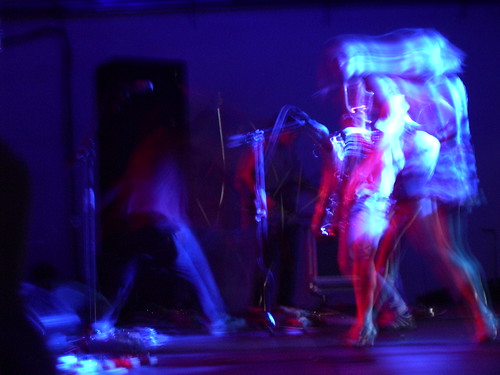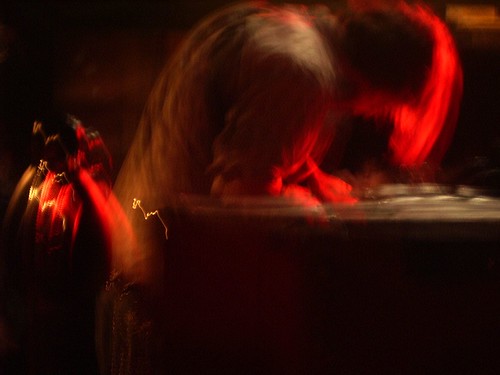I'm currently working on a book about Sonic Youth, for publication later this year. More info as I get it.
Hailing from NYC’s cerebral avant-garde scene, but pointedly obsessed with Pop Culture, Sonic Youth have spent the last quarter-century as rock’s most influential mavericks. They pioneered the ‘reinvention’ of the electric guitar (detuning it, attacking it with screwdrivers, and artfully ‘playing’ feedback), covered Madonna and jammed with Iggy and Neil Young, and grunge would never had happened without them. Along the way, their fluorescent, discordant noise split rock’s atom, redrawing the blueprint several times over and breaking every rule with subversive brilliance. Following Nirvana’s Youth-abetted breakthrough, 1992’s Dirty saw the group attempt a thrilling ‘crossover’ of their own, selling pro-feminist anthems and atonal rock’n’roll to MTV, with impressive success. Subtly expanding rock’s horizons and IQ level without ever losing touch with the kinetic thrill of overdriven, abused guitars, utterly committed to their exploration of all things Sonic, and ever-Youthful - fourteen albums later, they’re making the best and bravest music of their career.
I HEART SONIC YOUTH
by NICK ZINNER of YEAH YEAH YEAHS
“I THINK I was around 15 when I first saw Sonic Youth. They were playing a matinee all ages show in Boston; I hadn’t really heard much of their music before, but
was making a transition of my musical interests and my identity, from metal to punk, and my friend Jim was super into them. It was a small club, it was loud as fuck, and I remember Thurston was wearing a racing driver’s jacket. I was completely blown away, in every way, and basically the next day scrounged up every tool in my moms house and got to work making noise with my guitar on my 4 track. Suddenly, noise wasn’t just noise, but the start of an entirely new vocabulary - soft noise, beautiful noise, drone-y noise, melodic noise, noise-y noise... Basically, they had flipped the notion of what is music, what is guitar playing, and what is a song for me, remaining an influence to this day.
“Before I moved to New York city, my friends who lived there would tell me about SY sightings there, like ‘I saw Thurston in Other Music!’ Well, what records did he buy?! ‘I saw Lee coming out of a hardware store!’ What crazy tool of sonic destruction did he get?! They were heroes, yet totally accessible, and normal - like me
and you. Now, living in New York, they continue to have a strong presence in every artistic area: Art shows, improvisational collaborations at small clubs, DJ nights, and obscure film house benefits, to name a few ,while still playing amazing shows, making great records, and being more clued in to new experimental music than any critic or magazine could hope to be - no offence!”
ESSENTIAL PURCHASE
‘Daydream Nation’
(Blast First, 1989)
FINESSING THEIR detuned mayhem into something resembling Classic Rock, ‘Daydream Nation’ was a romantic, psychedelic vision of the violent magic of New York City. ‘Teenage Riot’’s ragged punk was an anti-hero ‘anthem’, while epics like ‘Cross The Breeze’ and ‘Trilogy’ were ambitious and often strangely beautiful. A perfect album, ‘Daydream Nation’ announced Sonic Youth’s triumphant ascension from the murky underground that birthed them.
FOLLOW-UP PURCHASE
‘Bad Moon Rising’
(Blast First, 1985)
ITS DISTURBING sleeve (a burning pumpkin-headed scarecrow) promised evil, and ‘Bad Moon Rising’ delivered, with atonal crescendos, menacing drones of feedback, and the Lydia Lunch-fronted nightmare surf-punk of ‘Death Valley 69’. Elsewhere, ‘Ghost Bitch’ glowered, while ‘I Love Her All The Time’ was psychotic psychedelic brilliance. The CD version adds their dread-laden ‘Hallowe’en’, and profane feminist statement ‘Flower’. Their bad-trip best.
ALSO RECCOMENDED
‘Murray Street’
(Geffen, 2002)
OTHER BANDS would’ve given up, had their arsenal of irreplaceable, modified guitars been stolen, as happened to Sonic Youth in 2000. But the setback inspired a renewed vigour within the band, the turbulent likes of ‘Rain On Tin’ and ‘Karen Revisited’ boasting brilliant rushes of avant-garde musicianship, and guest appearances from free-jazz saxophonists. ‘Murray Street’ was Sonic Youth’s most fearless - and also most accessible - album for years, an autumnal triumph.
WILD CARD
‘Washing Machine’
(Geffen, 1995)
AS THE grunge bubble burst, Sonic Youth abandoned more conventional structures for ambient noise and improvisational experimentalism. The title track (where Kim Gordon’s street poetry is swallowed up by waves of tranquil white noise) and noise-laden Cobain lament ‘The Diamond Sea’ are standouts, but the group’s adventurous nature on this album delivered an hour’s worth of passionately inventive music. Egghead space-rock perfection.
AVOID
‘Goodbye 20th Century’
(SYR, 1999)
A SINCERE tribute to their avant-garde roots, Sonic Youth collaborated with, and covered the works of, some of the greatest composers of the century. The result involved the destruction of a ‘treated’ piano (also included as CD-Rom footage), and puzzling versions of impenetrable pieces by John Cage and Yoko Ono. The concept and their ambition are to be applauded, but few are actually going to want to play this one twice. [This isn't actually true, but rather an attempt to justify suggesting that there's a Sonic Youth album you 'should' avoid, and betraying a desire not to frighten K!'s readership off from the joys of SY.]
BURN THESE!
‘Brother James’
Slashing detuned guitars and Kim Gordon’s inhuman howl collude over death-disco grooves for this blood-splattered rejection of religious dogma and guilt.
FIND IT: ‘Confusion Is Sex’, 1983
‘I Love Her All The Time’
Showcase for Thurston Moore and Lee Ranaldo’s instrumental abuse, a dippy love song exploding with drumstick-applied guitars and fierce screes - lunatic brilliance.
FIND IT: ‘Bad Moon Rising’, 1985
‘Death Valley 69’
No-Wave punk poet Lydia Lunch co-sang the Manson Murder lyric, as Thurston invoked surf-guitar godhead Dick Dale for the killer-bumblebee riffs. A Hallowe-en party classic.
FIND IT: ‘Bad Moon Rising’, 1985
‘Expressway To Your Skull’
Neil Young called this “the greatest guitar track of all time”, fitting tribute to the swooping symphony of atonal noise that drones throughout it’s epic climax.
FIND IT: ‘Evol’, 1986
‘In The Kingdom #19’
Ranaldo’s injurious car-wreck beat-poem is set to churning avant-noise, and the lit firecrackers Thurston threw at an unsuspecting Lee as he recorded the vocal.
FIND IT: ‘Evol’, 1985
‘Catholic Block’
Avowed lovers of pulpy Trash Culture, Sonic Youth knew Catholic Guilt only made the sin more delicious, as this psychotic, switchblade-wielding thrash declared.
FIND IT: ‘Sister’, 1986
‘Teenage Riot’
An irresistible, lazy melodic hook made this ragged, glorious rocker a perfect Summer alternahit. Written in salute to ragged, glorious (and lazy) Dinosaur Jr guitarist J Mascis.
FIND IT: ‘Daydream Nation’, 1988
‘Total Trash’
Brilliant, cacophonic slice of mischief, Sonic Youth dousing a dumb bubble-gum punk song with fearsome, dub-quaking noise, and dancing in the (audible) wreckage.
FIND IT: ‘Daydream Nation’, 1988
‘Tunic (Song For Karen)’
The Karen in question was the tragic anorexic singer/drummer with easy-listening legends The Carpenters. A sad, savage musing on stardom and it’s price.
FIND IT: ‘Goo’, 1990
‘Youth Against Fascism’
Featuring Ian MacKaye on guest guitar, this righteous salvo railed viciously against oppression, while expressing Thurston’s discomfort with the protest song as a format.
FIND IT: ‘Dirty’, 1992
‘Drunken Butterfly’
Shrieking vocals, guitars that sound like broken glass, walls of impenetrable noise, explosions of neon drone: this was how Sonic Youth played ‘pop’ music.
FIND IT: ‘Dirty’, 1992
‘100%’
Their big ‘hit’, a laconic slab of heavy riffage and revolutionary guitar squall, dedicated to recently-murdered Youth roadie (and Rollins’ buddy) Joe Cole.
FIND IT: ‘Dirty’, 1992
‘Bull In The Heather’
Sonic Youth were just as powerful coiled as unleashed, as this muted but brooding Kim Gordon groove attests. A slithering, sweet menace, from an underrated album.
FIND IT: ‘Experimental Jetset Trash & No-Star’, 1994
‘Washing Machine’
Embracing the looser approach of the album, Kim’s elliptic lyric toys with contrasting concepts of womanhood, before the song is swallowed by beautiful walls of white noise.
FIND IT: ‘Washing Machine’, 1995
‘Little Trouble Girl’
Kim Deal added girl-group harmonies to this beautiful, skewed song, about a mother/daughter relationship adrift on the choppy seas of adolescence.
FIND IT: ‘Washing Machine’, 1995
‘The Diamond Sea’
A powerful epic, its lyrics obliquely referencing Kurt (“The mirror’s gonna steal your soul”), over poignant, ear-scouring improvised feedback. A painful peak.
FIND IT: ‘Washing Machine’, 1995
‘Wildflower Soul’
Glorious moment from a difficult-to-love album, ‘Wildflower Soul’’s tender melodies gave way to some brain-splitting career-best skronkin’ from Moore and Ranaldo.
FIND IT: ‘A Thousand Leaves’, 1998
‘New York City Ghosts And Flowers’
Lee Ranaldo’s poetic lament for New York’s fading Bohemian under-culture, eradicated by Mayor Giuliani, barely contains its ire behind acrid, black-noise crescendos.
FIND IT: ‘New York City Ghosts And Flowers’, 2000
‘The Empty Page’
Referencing, perhaps, the fresh start signalled by the theft of their precious gear, this psychedelic howl of defiance opened an album recorded in the shadow of Ground Zero.
FIND IT: ‘Murray Street’, 2002
‘Kim Gordon And The Arthur Doyle Handcream’
Inspired by Mariah Carey’s recent career hiccups, this savage and hallucinatory attack on modern pop culture was Sonic Youth at their most satirical, and most sonically vicious.
FIND IT: ‘Sonic Nurse’, 2004
(c) Stevie Chick 2005




No comments:
Post a Comment